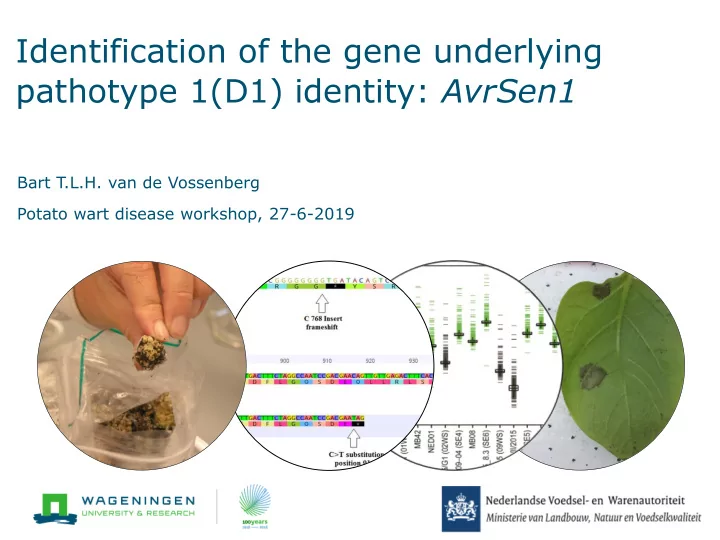

Identification of the gene underlying pathotype 1(D1) identity: AvrSen1 Bart T.L.H. van de Vossenberg Potato wart disease workshop, 27-6-2019
Synchytrium endobioticum pathotypes ▪ S. endobioticum isolates are further characterised as pathotypes ● Glynne-Lemmerzahl or Spieckermann bioassay ▪ Based on their virulence on a reference set of potato cultivars ▪ Approximately 40 pathotypes described to date ▪ Pathotype identity lies at the basis of phytosanitary measures 2
Resistance in potato ▪ Several major resistance genes and qualitative resistance loci for S. endobioticum pathotypes have been identified in potato ▪ Major R genes ● Sen1: 1(D1) resistance ● Sen1-4: 1(D1) resistance ● Sen2: 1(D1), 2(G1), 6(O1), 8(F1), 18(T1), 2(Ch1), 3(M1) and 39(P1) resistance ● Sen3: 2(G1), 6(O1), and 18(T1) resistance ▪ Can we identify the S. endobioticum avirulence gene corresponding to the potato Sen1 resistance gene? 3
Invading the host ▪ Zoospores encyst on the potato host cell ▪ spore content penetrates the host cell leaving the empty cyst wall outside ▪ Even in incompatible interactions, zoospores penetrate host cells after which an immune response is triggered resulting in a localized cell death Lange and Olson, Protoplasma 106, 97-108 (1981) 4
A model for Plant-pathogen interactions ▪ Plants evolved a basal defense mechanism against pathogens ● Triggered by pattern recognition receptors (PRR) ● Recognize pathogen/microbe associated molecular patterns (PAMPs/MAMPs), e.g. chitin ● The pathogen secretes effectors to prevent or suppress the immune response ▪ Pathogens secrete effectors to manipulate the host (e.g. hypertrophic growth) ● Can be recognized by plant R genes (=Avr) and trigger immune response ● Loss of Avr potentially avoids recognition by the host ● Pathotype 1(D1) versus higher pathotypes 5
The AvrSen1 candidate search profile ▪ Secreted (signal peptide, no TM domains or GPI anchors) ▪ Synchytrium endobioticum specific ▪ Present in pathotype 1(D1) isolates ▪ Absent in higher pathotypes ● Functionally absent (SNPs changing protein) ● Structurally absent (not present in the genome) 6
Building from a solid basis ▪ Using the pathotype 1(D1) isolate MB42 genome as reference ● 786 scaffolds ● 21.48 Mb ● 8,031 genes ● Hypothesized to contain AvrSen1 ▪ Read-mapping based prediction of absence ● Datasets from Van de Vossenberg et al. 2018 (BMC Evol Biol, 18:136) used to assemble S. endobioticum mitogenomes Van de Vossenberg & Warris et al. Nature Scientific Reports, 9: 8672 (2019) 7
The AvrSen1 prediction pipeline Van de Vossenberg et al. 8 BioRxiv doi.org/10.1101/646984 (2019)
The AvrSen1 candidate ▪ AvrSen1 gene candidacy was based on a combination of predicted structural and functional absence in higher pathotypes 9
Multiple predicted absence variants identified Van de Vossenberg et al. 10 BioRxiv doi.org/10.1101/646984 (2019)
Agroinfiltration of the AvrSen1 candidate and variants ▪ Modular Golden Gate Cloning system ▪ with and without signal peptide ▪ Agroinfiltration in plants with and without Sen1 11
AvrSen1 triggers a HR in a Sen1 dependant manner Agroinfiltration scores: 0 = no cell death; 1 = 50% of area shows cell death ; 2 = 100% of area shows cell death Van de Vossenberg et al. 12 BioRxiv doi.org/10.1101/646984 (2019)
Multiple AvrSen1 variants can co-exist in fungal isolates Van de Vossenberg et al. 13 BioRxiv doi.org/10.1101/646984 (2019)
Van de Vossenberg et al. BioRxiv doi.org/10.1101/646984 (2019) Dominant AvrSen1 variants 14
Conclusions ▪ We identified the AvrSen1 gene in S. endobioticum pathotype 1(D1) isolates using a comparative genomics approach ▪ AvrSen1 is recognised by potato plants carrying the Sen1 R gene and defines pathotype 1(D1) identity ▪ Paralogs in other pathotypes consist of truncated variants which are not recognised by Sen1 plants ▪ S. endobioticum populations may contain both the avirulent AvrSen1 as the truncated AvrSen1 variants 15
Acknowledgements WUR Plant Breeding Thank you for Richard Visser, Jack Vossen, Gert van Arkel, Marjan Bergervoet, Charlotte Prodhomme your attention WUR, Biointeractions and Plant Health Theo van der Lee, Marga van Gent-Pelzer, Balazs Brankovics WUR, Bioinformatics Sven Warris Other Jarek Przetakiewicz (IHAR, Poland) Margriet Boerma (HLB, NL) Gerard van Leeuwen, Patricia van Rijswick, Lucas van der Gouw, Annebeth Kloosterman (NVWA, NL) Hai Nguyen (AAFC, Canada)
An alternative bioassay targeting aboveground plant parts Van de Vossenberg et al. Phytopathology 109(6):1043-1052 (2019) 17
Inoculated aboveground plant parts show same interactions as tuber-based assays Potato cultivar Suspected Inoculum interaction 1(D1) 2(G1) 6(O1) 18(T1) mock Deodara S: 1, 2, 6, 18 Inoculated buds 11 15 12 13 4 3 (23 %) c symptomatic 8 (72 %) 7 (47 %) 3 (25 %) 0 Producent S: 2, 6, 18 ; R:1 Inoculated buds 8 16 12 12 4 symptomatic 0 9 (56 %) 10 (83 %) 7 (58 %) 0 S: 2 a , 6 a , 18 ; R:1 Talent Inoculated buds 8 12 12 10 4 symptomatic 1 b 4 b 4 (33 %) d 0 0 Saphir S: 2 ; R:1, 6, 18 Inoculated buds 8 12 12 12 4 symptomatic 0 3 (25 %) 0 0 0 Belita R:1, 2, 6, 18 Inoculated buds 8 12 12 12 4 symptomatic 0 0 0 0 0 ▪ Opens up possibilities for to test candidate Avr genes using leaf- based Agrobacterium tumefaciens mediated transient transformation assays 18
Recommend
More recommend